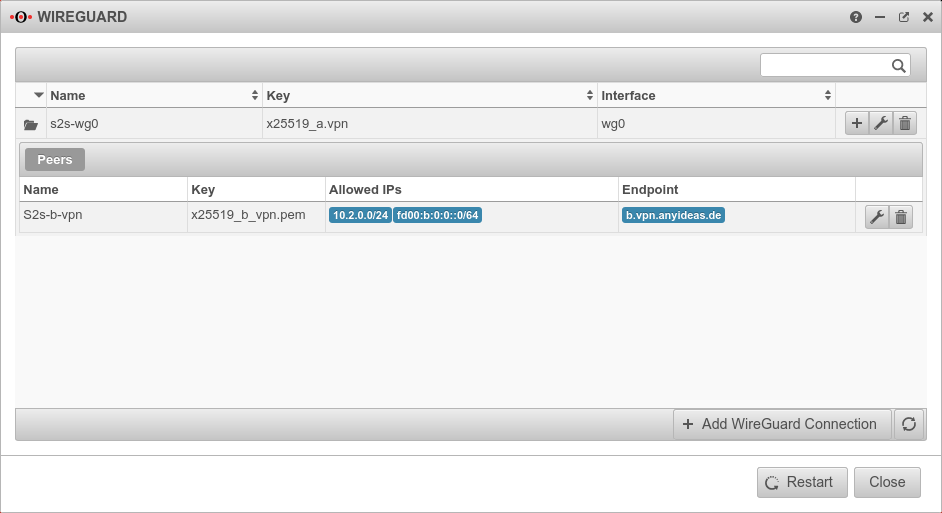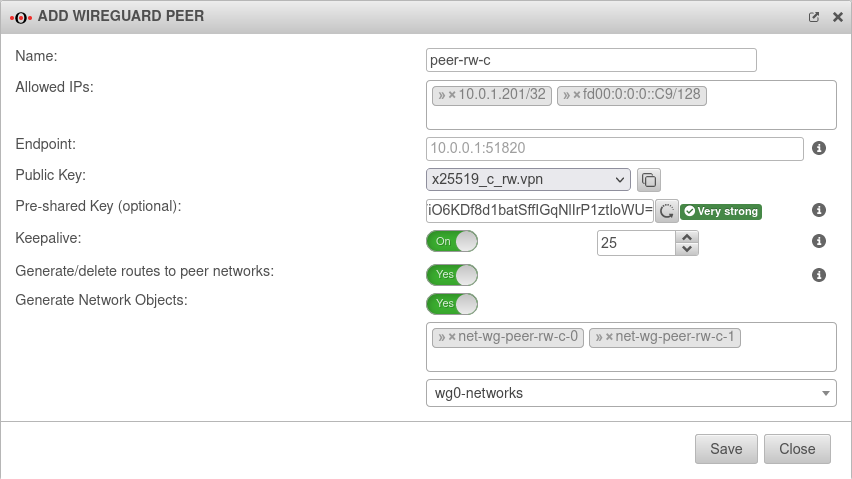notempty Dieser Artikel bezieht sich auf eine nicht mehr aktuelle Version!
notempty Der Artikel für die neueste Version steht hier
notempty Zu diesem Artikel gibt es bereits eine neuere Version, die sich allerdings auf eine Reseller-Preview bezieht
Add peer to an existing WireGuard conection
Last adaptation to the version: 12.2.2
New:
notemptyThis article refers to a Resellerpreview
-
Add (remote terminal) Peer
If a WireGuard connection already exists in which the UTM serves as a server, an additional peer can be added that runs on the same port. It uses the same certificate to authenticate the connection as an existing connection.
For additional remote terminals (peers), their own public key is required, as well as their own PSK.
Button Add peer of the connection you want to use
|

|
|
|
|
|
| Caption |
Value |
Description
|

|
| Name |
peer-rw-c |
Description of the remote terminal (here: a roadwarrior)
|
| Allowed IPs: |
Site-to-Site » ✕10.2.0.0/16 » ✕fd00:b:0:0::/64 |
Site-to-Site
Local net IP of the remote terminal
|
| Roadwarrior» ✕10.0.1.201/32» ✕fd00:0:0:0::C9/128
|
Roadwarrior
IP of the transfer network (» ✕…/32 or » ✕…128)A roadwarrior uses only the tunnel IP
|
| Endpoint: |
Site-to-Site
c.vpn.anyideas.de:51820 |
Site-to-Site
Public IP or within the public DNS resolvable FQDN with listening-port of the remote terminal
|
Roadwarrior
|
Roadwarrior
Can remain blank if no connection is to be initiated from the UTM
|
| Public key: |
x25519_c_rw.vpn |
Public key of the remote terminal in the x25519 format.
Only keys that have no private key can be selected.Public key present but not selectable? Only keys for which there is not yet a connection on this interface can be selected. The PublicKey must be unique within a connection, as the routing of incoming packets is carried out via it.
If the same PublicKey is to be used for a peer, e.g. for a fallback, another WireGuard connection must be created for this.
|
|
Site-to-Site
If the public key of the remote terminal is not yet known, this button can be used to open the import of the key management.
|
Roadwarrior
If the public key of the roadwarrior is not yet known, this button can be used to open the import of the key management.
We recommend creating the key pair for the Roadwarrior on the UTM and then storing it securely. Approach:
- Click the button. This opens the key management and the import dialog
- Import dialog Close
- Button Add key
- Choose a unique name
- Select as Type: the format X25519 and Save
- Export private part and public part of the key in the RAW format
(The format is important, because it's needed in the configuration file of the roadwarrior.)
- Afterwards import the public part of the key again
(This process is necessary, because in the selection dialog of the assistant only keys without private key part are available.
The private part of the key is used in the counterpart device. It can be entered in the WireGuard Client under PrivateKey.
|
| Pre-Shared Key: |
…QxJqz22W4/FWipaxs= |
Pre-shared key for further securing the connection (optional)
|
|
Generates a very strong pre-shared keyThe pre-shared key must be identical at both ends of the VPN connection!
|
| Keepalive: |
Off |
Regularly sends a signal. This keeps connections open on NAT routers. On Activation is recommended.
|
25 |
Interval in seconds at which a signal is sent
|
| Generate network objects: |
No
» ✕net-wg-rw-c0 » ✕net-wg-rw-c1 |
Generates network objects (IPv4 and if necessary IPv6) for the remote terminal (here: for a roadwarrior) on activation Yes.
The automatic suggestion can be changed.
|
| Network group: |
wg0-networks |
Assigns the newly created network objects to a network group
|
|
|

